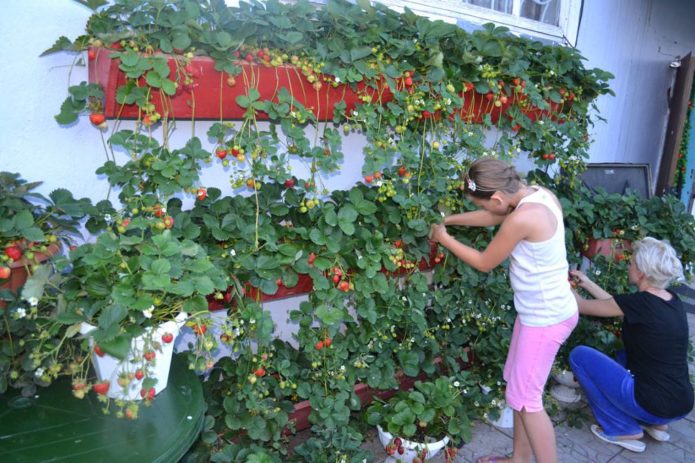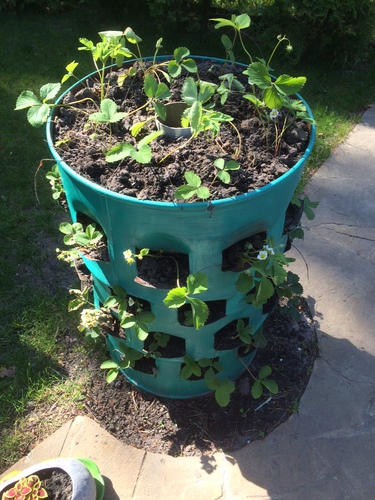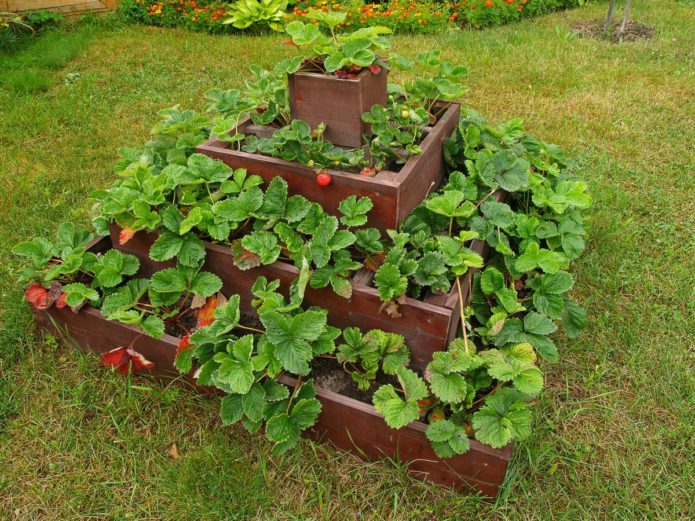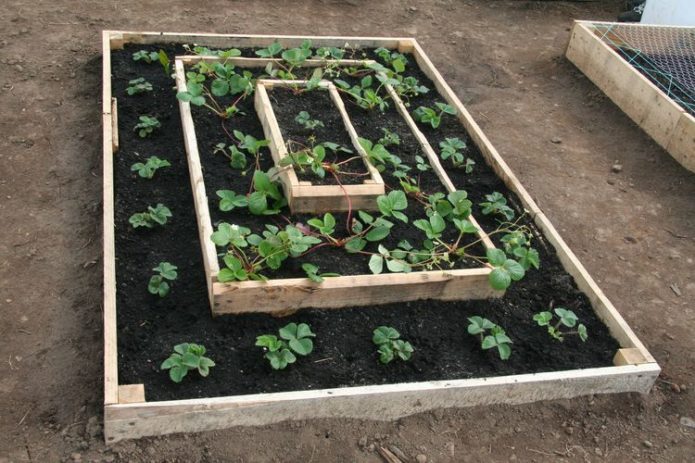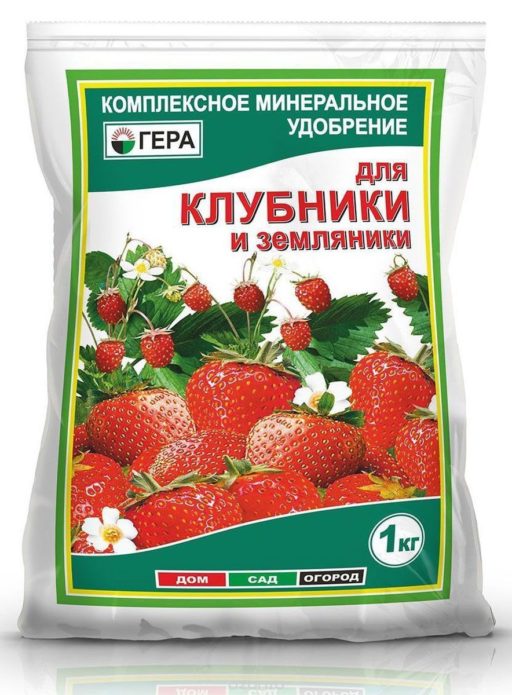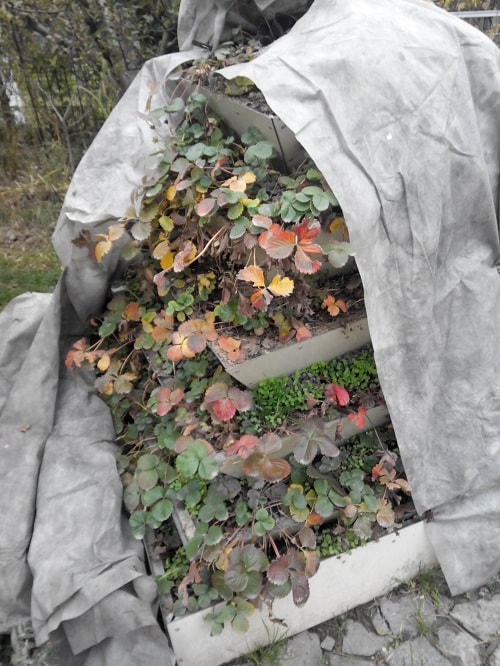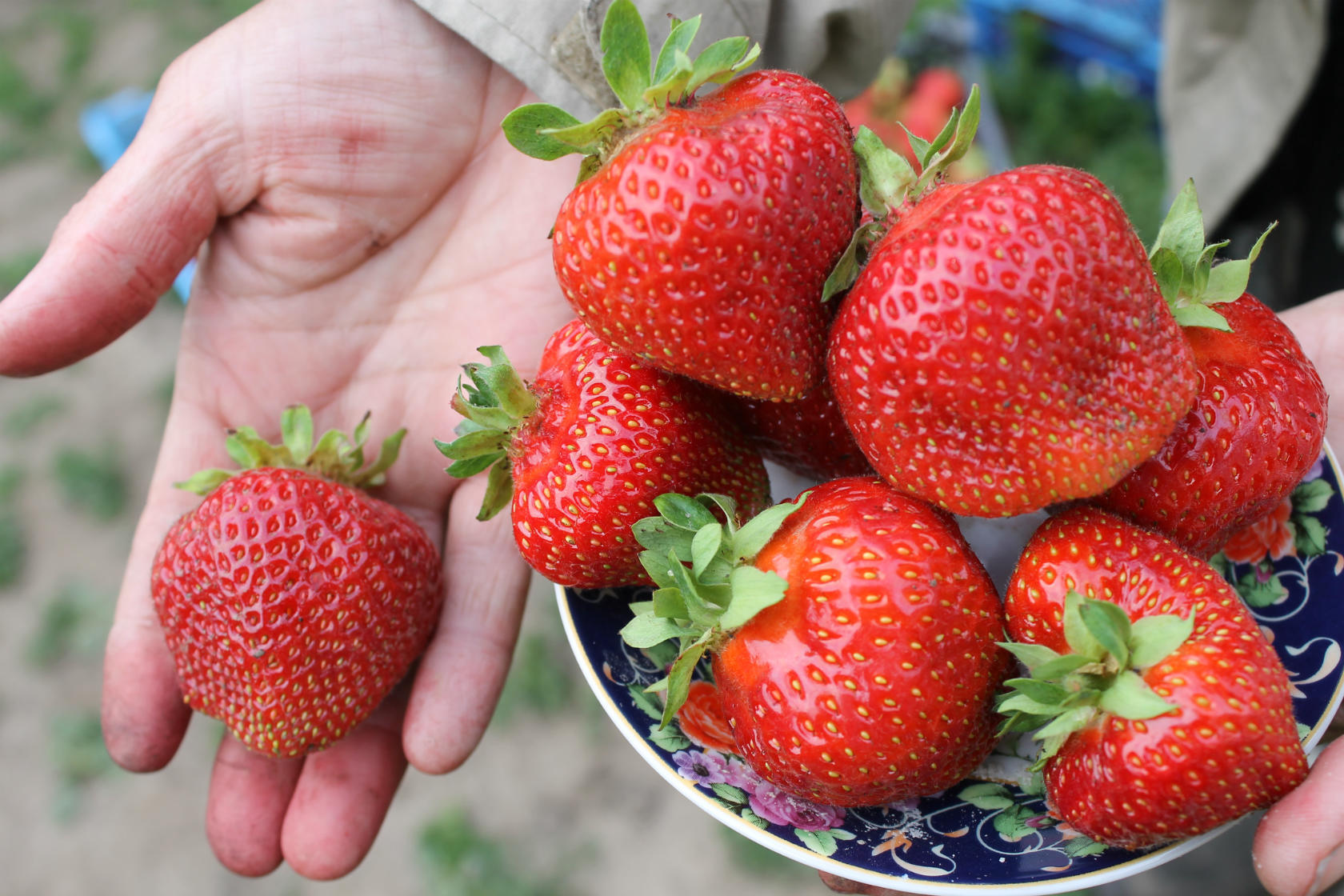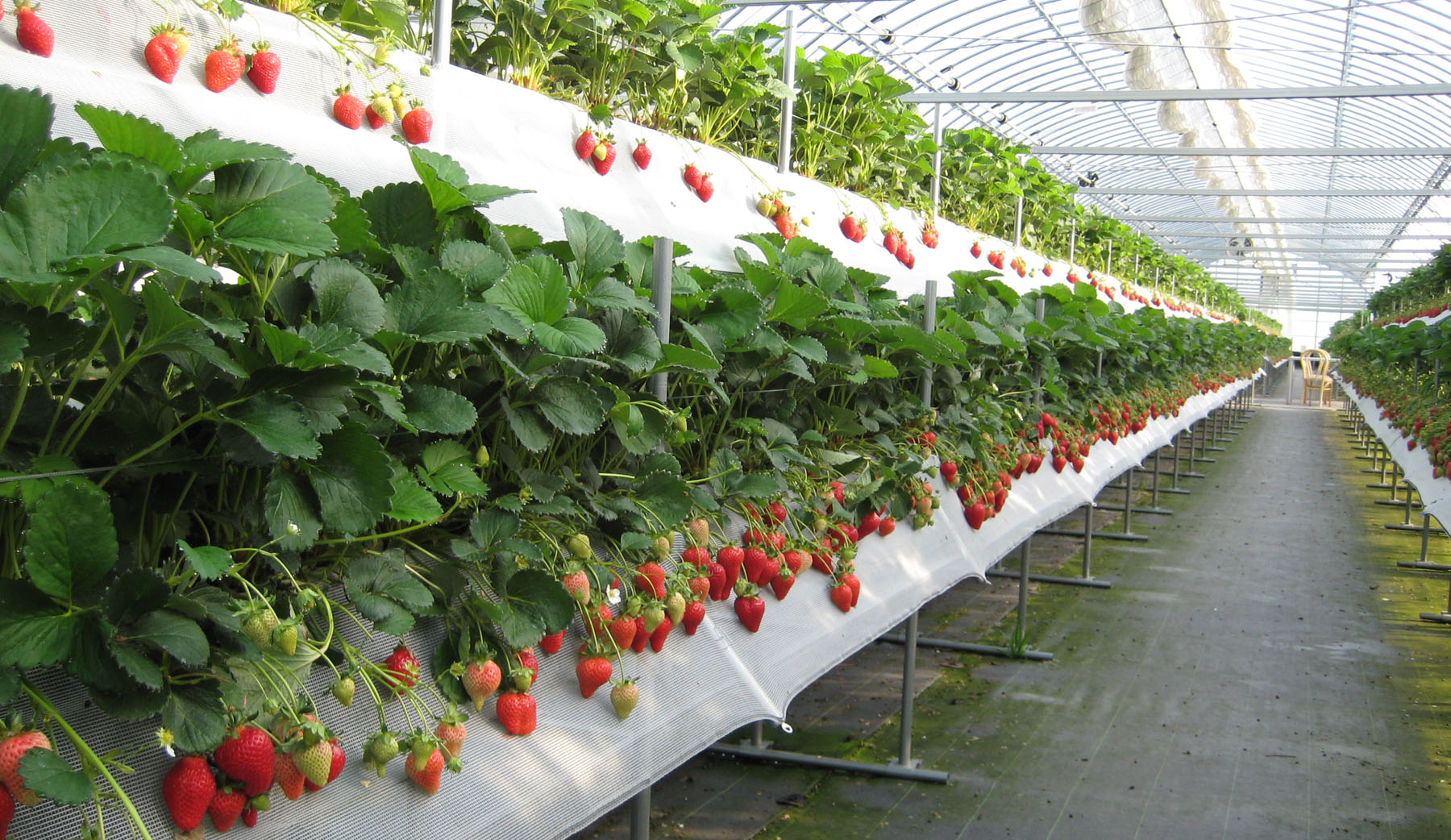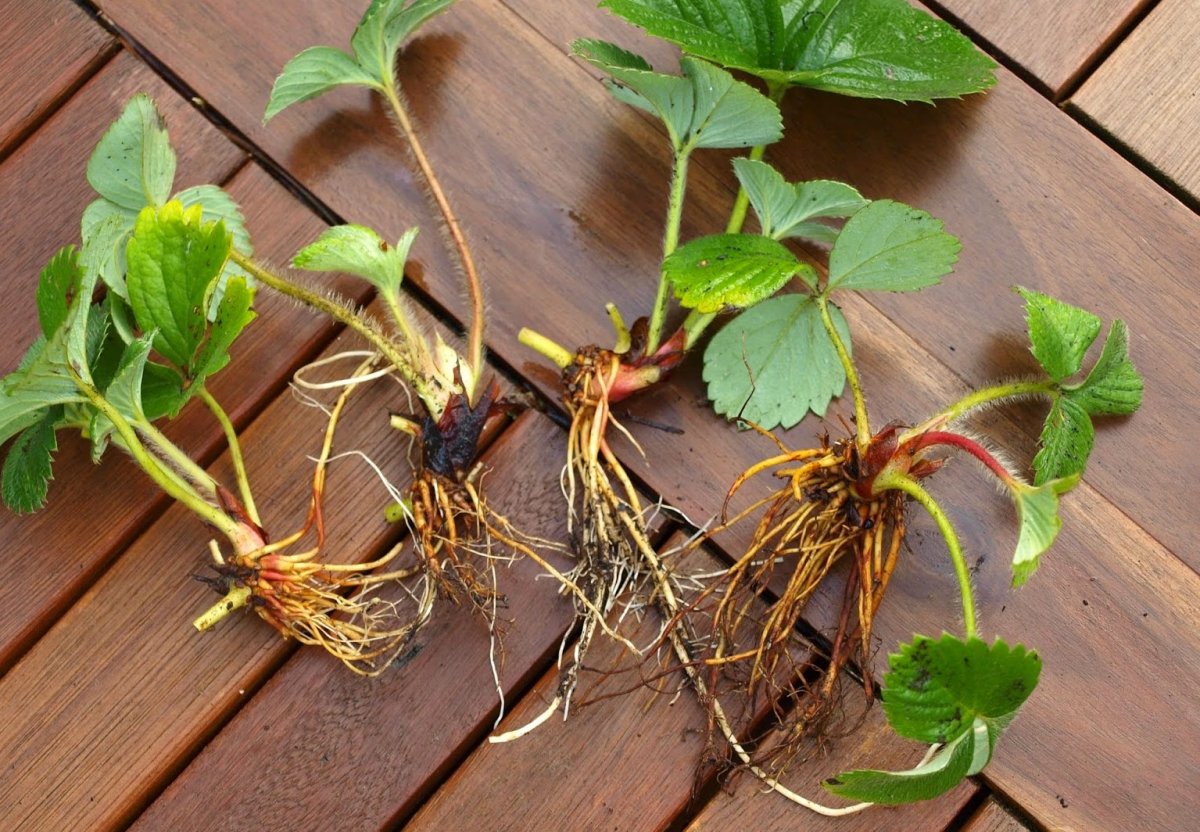Growing various crops in a vertical way significantly saves space on the site. And if earlier only curly vegetables were grown in this way, then it was the turn of strawberries. Many options for vertical cultivation have been invented for strawberries, especially ampel varieties are often cultivated in this way.
Content
Vertical strawberry cultivation methods
Most often, various improvised materials are used to make vertical "beds": old barrels, bags, boxes, etc. However, sometimes serious gardeners also equip quite capital buildings from new plastic or metal pipes, rolled metal or boards.
Growing in vertical beds
Vertical cultivation is beneficial when the available area is limited. Most often it is used in greenhouses, and sometimes even on balconies. This is not to say that this approach has many advantages or is easier to implement than traditional horizontal cultivation of strawberries in conventional beds. But the benefit in saving space is obvious, and in some cases they decorate a summer cottage in this way, giving it some originality.
The first thing that comes to mind for an inexperienced amateur who first heard about vertical beds is to plant strawberries in boxes or pots, which are suspended in one way or another on a main wall (house, barn) or a specially erected vertical surface made of boards or metal mesh. Indeed, this approach exists: pots, pots or boxes of one size or another are placed one above the other.
It is especially effective to use their walls in capital greenhouses, constructing shelves on them in the required quantities and placing containers with strawberries on them. They can be positioned from floor to ceiling, as long as the boxes above do not obscure the ones hanging below them from the light. From each square meter of the greenhouse in this way, several times more products are obtained than with traditional cultivation.
Growing in five-liter bottles
5 liter bottles of drinking water or technical fluids can be used as free planting pots. To do this, they are cut into two unequal parts: the one with the lid is used for planting, turning it upside down, and the second is used as a shelf-pallet, securing it with thick wire on a vertical surface. The lid is screwed on loosely so that excess irrigation water can drain into the sump.
It is necessary to take into account the small volumes of this "pot": it will not be easy to keep track of the required soil moisture.To avoid waterlogging, a drainage layer is laid down. However, if you place a layer of padding polyester there, excess water will linger in it for a while, and after the soil dries up, it will return back to the roots.
Growing in tire pyramids
In the open field, various pyramids are often arranged for planting strawberries. The construction of boards really looks like a regular pyramid, on which strawberries are arranged in several tiers. Especially often, remontant strawberries are cultivated in a pyramidal manner. 4–5 bottomless boxes of different sizes, 20–25 cm high, are hammered from the boards. An irrigation pipe with holes for water is driven into the ground, and boxes are placed on it one by one, starting with the largest one. Fertile soil is poured into each box, and an irrigation hose is put on the end of the pipe from above. Strawberries are planted in each of the boxes around the perimeter.
An almost free option for a pyramidal bed is a construction made of unusable car tires. You just need to collect tires of different diameters: from KamAZ to Zaporozhets. The metal cord inside the tire reliably holds the structure. The garden bed can be of any size, depending on what tires were found. Even if they are the same, not a problem: they arrange a cylindrical bed, planting strawberries in the side holes made in the tires.
True, one must understand that tires are not a completely environmentally friendly material, but they are unlikely to cause more harm than the conditions in which a significant part of the townspeople live now. It is especially unpleasant when the tires begin to smell in the strong sun. To minimize the effects of this, they can be painted with white paint.
Growing in bags and barrels
An imposing plastic bag filled with soil is an almost ready bed for planting strawberries. It must have a capacity of at least 50 liters. A vertical irrigation pipe with holes is placed inside the bag, and holes are cut in the walls for planting strawberries. The distance between them is from 20 cm.
Instead of bags, old barrels, both metal and plastic, are often used. Only the barrel must be cleaned of rust and dirt, and drain holes must be drilled in the bottom, and holes 8–10 cm in diameter in the walls for planting strawberries. Drainage (crushed stone, pebbles) is placed at the bottom and an irrigation perforated pipe is placed.
Fill the barrel gradually, while planting strawberries, starting from the bottom tier of the cut circles. Of course, the entire surface of the barrel is planted with strawberries.
Growing in pipes
Growing strawberries in polyethylene or polyvinyl chloride pipes has become very popular. Pipes are placed both horizontally and vertically (in case of vertical arrangement, they are suspended on vertical frames). Strawberry pipes should have a diameter of about 200 mm, irrigation pipes - about 20 mm. A thin tube is inserted into a thick one, and strawberries are planted in the holes made in the tube in a checkerboard pattern. However, growing strawberries in pipes is a topic for a separate detailed discussion outside the scope of this article.
Technology for growing strawberries on vertical surfaces
It turns out that the technology of planting strawberries in the vertical version differs little from the traditional one, and caring for it is even more so, although, of course, there are certain nuances.
Preparing a place for growing strawberries
Depending on the chosen planting method, the containers can be positioned in different ways, but in any case it should be a well-lit place. A light shade for several hours a day will not harm the strawberries, it is even better than the sun, but most of the time the garden bed should be illuminated by the sun. This is especially important to consider when growing strawberries in pots or boxes suspended from a wall of a house, a fence or a specially erected vertical surface. In addition to lighting, it is important to protect vertical beds from cold winds.
In the case of a pyramid of boards, tires, as well as growing in bags or barrels, such a "bed" can be placed anywhere, even on the asphalt or along the path. It is important that there are no tall trees nearby that block the sunlight, and that raspberries or blackberries do not grow either: these are undesirable neighbors of strawberries in terms of the same pests.
When choosing pots or boxes, it is important to evaluate their size: in any case, each bush should have 3-5 liters of soil. Strawberry roots penetrate into the ground up to 20–25 cm, it is necessary that they have room to grow. Strawberries cannot live and bear fruit in two-liter containers for more than 1-2 seasons.
Soil preparation for strawberries
In addition to the requirements for the location of the garden, it must be borne in mind that for vertical cultivation, you will have to specially prepare the soil: most likely, worms will not creep into a pot or a pyramid, and there will be few beneficial bacteria there. There are a lot of soil options, but in any case, it should be fertile, loose, moderately water-absorbing, slightly acidic (pH 6.0–6.5). You can do almost without buying something special: if you add half a bucket of good compost and a half-liter can of wood ash to a bucket of garden soil, this composition will have enough fertility. It is even better if you add up to 20% peat to the mixture.
The soil must be poured onto the drainage layer: at least 10 cm of pebbles, fine gravel, expanded clay!
If the garden soil is not loose enough, clayey, river sand, sawdust or vermiculite are added to the described mixture. It is unacceptable to take land from the garden where strawberries, raspberries or nightshades have recently grown. In any case, it is highly desirable to neutralize the garden soil by spilling it with boiling water or a pink solution of potassium permanganate.
Landing scheme
For vertical cultivation, any convenient planting scheme is used, depending on the chosen version of the "bed". There is only one limitation: the distance between individual bushes should be at least 20 cm. Hence, it turns out that, for example, only one bush can be placed in a plastic bottle or a standard flower pot. In boxes - depending on their size. And in barrels or bags, as they said, holes are made in the side walls every 20-25 cm.
Landing dates
Planting times are almost the same as in the case of traditional beds and depend mainly on the climate of the region. So, in the south, they prefer spring planting, from about the end of March to the beginning of May. It is also possible to plant in October, but it must be understood that in the case of vertical cultivation, this can be carried out only in those regions where there is practically no severe frost: the roots of a strawberry that has not completely taken root can painfully perceive severe hypothermia in small containers.
In the middle lane, "horizontal" strawberries are most often planted from early August to mid-September; vertical planting must be completed no later than the beginning of autumn. In the northern regions, it is better to start planting in May. In principle, seedlings bought in cups can be planted with a clod of earth in any region throughout the growing season.
Fertilizers applied at planting
Strawberries can be planted in the above soil (soil mixed with compost, peat and ash) and without the use of mineral fertilizers, especially if the soil on the site is fertile, and the compost (or well-rotted manure instead of it) is of really high quality. Mineral fertilizers are best left for subsequent fertilizing. But if it is known that the land on the site is not rich in nutrients, you can add a pinch of superphosphate and potassium sulfate to the bucket of the mixture.
Fertilizers containing chlorides should not be used!
Landing
For vertical plantings, as well as for ordinary plantings, both rooted whiskers and seedlings grown from seeds are used as planting material. Young adult bushes can also be planted, but not older than two years. Mustaches are ready for planting usually in August; at this time, in most regions, it is quite possible to plant them in vertically located containers, pipes, tires, etc.
If an August or fall planting is unacceptable, the mustache can wait until spring.
The bad thing is that the mustache planted in the first year will almost not yield a crop, and the vertical structure will stand idle, and you need to take care of it ... True, remontant varieties will already give a good harvest by the fall of the first year. Seedlings grown from seeds can yield a harvest sooner, but few people do this at home: the process from seed to seedlings is long and difficult.
So that the bed does not work idle, they try to plant young grown bushes in it from an ordinary, horizontal plantation. When a 1–2-year-old bush is planted in spring, it will yield a crop in the same season, it is only important to try to transplant it with a clod of earth without disturbing the root system. However, it is better to plant a mustache together with an earthen lump. If the digging with a lump failed, the roots are bare, they are dipped in a clay chatter before planting.
Whatever the planting material is, the most important rule is not to cover the growth point with soil. This rule applies to both the planting itself and the mulching of the plantings, which is carried out after watering the bushes in a new place. Taking into account the peculiarities of vertical plantings, in the first week you have to water the beds a little every day, or even more than once. As the strawberries take root, watering is gradually reduced.
If the planted strawberries very quickly threw away the buds, they must be cut off. It can only be allowed to bloom and bear fruit after it has completely taken root and gives several new leaves. At this time, you can start and feed the plants.
It must be borne in mind that strawberries cannot live long in a confined space. If on ordinary plantations the period of normal fruiting does not exceed 3-4 years, and in the fifth year strawberries are destroyed, then new vertical beds have to be started every 2-3 years.
Video: planting strawberries in a vertical pipe
Strawberry care
Strawberries on vertical beds need the same conditions as on ordinary ones, only creating them is a little more difficult.
Watering, feeding
You have to water vertically planted strawberries more often than usual, but in no case should you pour it. On hot days, mature plants may even need to be watered daily. If irrigation is equipped in the form of internal pipes, then, in addition to them, water must be given from above the bed, in the usual way, from a watering can or a ladle. In the case of small containers, it is scary not only to dry out the soil, but also to swamp it. To prevent this from happening, many gardeners add a hydrogel to the soil mixture: it absorbs excess moisture, and then gives it back to the soil as the moisture decreases.
Strawberries are fed every 7-10 days during watering. To do this, you can use both weak infusions of mullein or mown grasses, and mineral fertilizers. It is more convenient to use special mixtures for berry crops. With weak growth of the leaf mass, they are fed with urea or ammonium sulfate (10-15 g per bucket of water). With the onset of fruiting, nitrogen fertilization is reduced.
Pruning
On the bushes, the number of whiskers is regulated: as a rule, more than 5 pieces are not left. In autumn, cut off all dried and damaged leaves and the remains of peduncles, sending strawberries in the winter with a minimum of fresh green leaves. Starting from the second year of life, after the end of fruiting, they carefully cut off all the foliage without affecting the horns, and give nitrogen fertilization. After that, the newly growing leaves are left, and if new whiskers appear, they are immediately removed.
Protection against frost, pests and diseases
Since pots or boxes can freeze to the ground in winter, in most regions they should be removed from vertical surfaces, placed on the ground and covered with coniferous or spruce branches. In the case of more bulky structures (bags, barrels, pipes), they are covered with spunbond for the winter in a problematic climate.
Diseases attack vertical plantings less often than ordinary ones, since they are better ventilated. However, powdery mildew or various spots can attack strawberries. The prevention of infection is the autumn and spring pruning of suspicious leaves and spraying the plants with Bordeaux liquid: before flowering - 2-3%, after flowering - 1%. At the very beginning of spring, it is advisable to process strawberries with a weak solution of potassium permanganate (0.10-0.15%).
Of the pests, the most dangerous are strawberry mites and weevils. To destroy them after picking berries, use a solution of Karbofos (3 tablespoons per bucket of water), after which they cover the bed with a film for 2 hours. Karbofos is active against many other insects. In wet years, slugs and snails can crawl even on vertical beds. It is better to catch them with special traps, since preparations based on metaldehyde are very effective, but rather toxic.
Video: berries in the simplest vertical bed
Vertical cultivation of strawberries saves space on the site, but requires additional labor costs. What is easier for a gardener, everyone decides for himself.
